
It allows to keep PV going, with more focus towards AI, but keeping be one of the few truly independent places.
-
Thanks, I made topic as for other announcments
http://www.personal-view.com/talks/discussion/5714/jvc-consumer-2013-camcorders
-
I am at CES and here is a report from the show floor today.
Pansonic showing the GH-3, of course. One Panasonic person said the GH-3 video is now as good Vitaliy's hacks :)
Panasonic also showing a 4K video camera prototype.
Sigma continues to show their 19 and 30mm micro four thirds lenses and there was a hint that there may be a future 50mm micro four thirds lens from them.
I did not yet get to the Olympus booth, nor JVC. Pentax had a corner of the Ricoh booth.
Lots of Wi-Fi capable cameras - Nikon has a $60 adapter that adds Wi-Fi to many cameras in their line up. Interfaces to iPhone and Android phones for complete remote control and access.
Nikon, Polaroid and Samsung showed cameras running Android OS. I see these as market experiments to see what happens. Adding a public OS to the camera means software developers can add capabilities and access anything the Android OS and SDK make available. As to battery life, the general sense is that cameras eat batteries, period. Adding Android doesn't make that much of a difference - the camera itself eats up too much power. One vendor said their Android camera gets about 150 shots per battery charge.
Everyone is showing 4k HDTV are, as some call it, Ultra TV or similar names. 4k has four times the resolution of today's HDTV.
As I understand it there will be - but is not yet - a 4k Bluray standard. For the time being, there is no 4k content available for anyone, but the show demonstrations are very sharp, well shot imagery.
For most consumers, in a typical home, with a typical screen size, and with typical eyesight, might not really notice the difference between 2k and 4k. Some of us may notice because we care about such things, but the 4k marketing message was not yet clear to me other than "it really is way cool".
Samsung, and presumably others, were showing 4k 3D and here, the 4k did show its capabilities. 3D likes detail, and more resolution also enables some very clean, narrow parallax images that would not be possible with less pixels. But the market demand for 3D is still muddled although is growing slowly.
Tomorrow I hope to find Olympus and some other camera vendors, plus visit some of the small international vendors who have show interesting technologies before we see them from the big vendors.
One area I follow is the consumer market for 3D cameras. As you may know, the week before Christmas, B&H Photo and Walmart.com both showed the Fujifilm W3 as discontinued. Amazon and B&H are both running half price sales on the Toshiba Z100 consumer 3D camcorder, and the Lumix 3D1 is no longer carried by Amazon (itself) and is now available only from 3rd party vendors.
Here's what I picked up from reputable people connected with the companies. Fujifilm W3 sales have fallen off and they are not now being manufactured but will continue to ship from inventory for the foreseeable future. If demand resumes, they will make more.
Sony confirmed that the Bloggie 3D camera has been discontinued, but they have continued to evolve the Sony TD10 into the TD20 into the TD30 3D video camcorder (uniquely records dual 1920x1080p streams).
Toshiba was not showing any cameras at all at this year's CES and no one knew anything about the Toshiba Z100.
And then Samsung introduced the first single lens 3D camera.
My thoughts are that there was a mismatch between low end consumer 3D cameras and the target customer. The consumers likely to pursue 3D may be the higher end purchaser looking for great solutions, not necessarily lowest price.
Samsung is going after this higher end market with a interchangeable lens camera and their first 3D lens, priced more like a GH-2 and m43 lenses. The NX300 is a higher end, more sophisticated customer, buying an APS-C sized sensor. The 3D lens is also an f/1.8 2D lens that is reported to be very high quality as a 2D lens. If this lens sells well, they are likely to introduce other 2D/3D lenses. They 3D results out of this lens, from the demo, are quite good.
First 3 photos attached Panasonic illustration of the Canon solution, big camera, big lens, huge backpack versus the m43ds solution, with modest camera, small lenses, small backpack. They should do more comparisons like this. I like small.
2nd photo shows the m43 lens line up from all vendors. Sorry I didn't get these two rotated to vertical.
3rd photo shows the 300mm telephoto form Kenko Tokina. This is a telescope like design, which uses a couple of internal mirrors to increase the lens length.
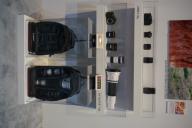
 P1000688.jpg800 x 533 - 100K
P1000688.jpg800 x 533 - 100K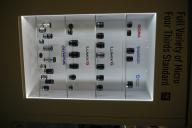
 P1000690.jpg800 x 533 - 83K
P1000690.jpg800 x 533 - 83K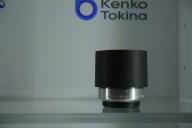
 P1000692.jpg800 x 533 - 49K
P1000692.jpg800 x 533 - 49K -
More photos
First - the 4k prototype from Panasonic.
Second - the line of Panasonic "sports" or "Action" cameras. Everyone is trying to catch up to GoPro and has their own spin on cameras.
Third photo - the insides of the GH-3.

 P1000693.jpg800 x 533 - 84K
P1000693.jpg800 x 533 - 84K
 P1000696.jpg800 x 533 - 105K
P1000696.jpg800 x 533 - 105K
 P1000707.jpg800 x 533 - 111K
P1000707.jpg800 x 533 - 111K -
More photos
1st photo. More of the insides of the GH-3. Because I was shooting with a GH-2, the sales rep removed the glass shield for this photo opportunity. He said he likes people shooting with the Lumix cameras.
2nd photo - Canon's Powershot line. They introduced the Powershot N which is a small square camera. Definitely a rethinking of the lower end camera line. All camera companies are trying to figure out what to do about smart phone cameras. The N camera is square (not rectangular like most cameras), very thin. You take photos and can apply Instagram like filters to the photo (and in my view, ruin perfectly good photos, but what do I know about Instagram) and then has Wi-Fi connectivity so that you can work with your smart phone to upload to sharing sites.
3rd photo - a map of the Canon booth. They sprawl so much they have their own map. Big like their cameras. Oops, my bias is showing.
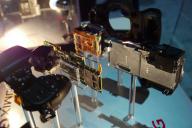
 P1000716.jpg800 x 533 - 118K
P1000716.jpg800 x 533 - 118K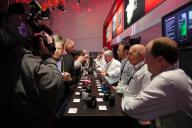
 P1000751.jpg800 x 533 - 126K
P1000751.jpg800 x 533 - 126K
 P1000755.jpg800 x 533 - 104K
P1000755.jpg800 x 533 - 104K -
1st photo - Samsung NX300 camera, with 2 lenses.
2nd photo - NX300 with the 2D/3D lens on it.
3rd photo - 3D output from the NX300 with 2D/3D lens attached. I shot this to illustrate the amount of parallax generated by the lens. The NX300 has a live 3D HDMI output, which I think is the first such capability on a camera like this. The 3D display is an active shutter type display, so in this image you are seeing both the left and right images displayed simultaneously on the TV - which enables us to see how much parallax exists in the image.
I looked at it through the 3D glasses and I thought it was a very good 3D live video. I shoot 3D video with dual GH-2s and am very picky about 3D quality - this was very good quality video.

 P1000800.jpg800 x 533 - 97K
P1000800.jpg800 x 533 - 97K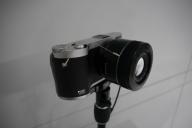
 P1000815.jpg800 x 533 - 53K
P1000815.jpg800 x 533 - 53K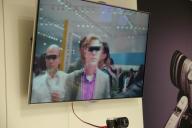
 P1000821.jpg800 x 533 - 98K
P1000821.jpg800 x 533 - 98K -
Vitaliy, would you like these on a different thread or is this a good one for these updates?
Ed
-
@edwardm Did you get any real close ups of the insides of the gh3?
-
Not as close as I wished. I will try to swing by the Panasonic booth again in the next couple of days and use a different lens to get closer. I just had the kit 14-42 on the camera while shooting these but I have other lenses with me.
-
Big thanks. This topic is perfect.
I'll later make some post about 3D cameras and "geniouses" who sell and market them.
-
Polaroid announced a unique Android-based camera, whose sensor is built in to the lens. This has led to some confusion that I can clear up.
They will be shipping in the spring, a micro four thirds adapter. The adapter itself also includes a sensor but can then work with any m43 lens. In other words, the camera body does not have a sensor - its in the kit lens, or in the adapters.
Adapters for other lenses are expected a short time later. Pricing is suggested to be surprisingly affordable. Each adapter will have a sensor built in but many different lenses can be used with the adapter. The m43 adapter is expected in April, and a second lens adapter for another lens line will also likely be out in the spring.
This is a different kind of camera on many levels. Android-based, hope to see 3rd party apps developed for the camera features. Emphasize image sharing capabilities (FB, Twitter, etc).
-
Fujifilm HS50 EXR has world's fastest autofocus at 5/100ths of a second. System automatically selects phase detector or contrast focusing system. Startup time is 1/2 second as is time between shots. Has a 1/2" sensor. $549
SL1000 has 1/2.3 sensor, all of these cameras support the cha cha mode imported from the W3 and store images in mpo format. These are a super zoom bridge type cameras. This one is priced at $399
Both cameras support 3D "cha cha" mode photo taking. That is take one image, move camera a bit, take 2nd camera. Performs in camera alignment and then stores to MPO file format. This is a literal port of the Fujifilm W3's "Adv 3d" cha cha mode. Which means if the W3 sort of fades away, parts of it will continue to live on.
X20 is a compact version of the x pro 1, basically with. 2x faster processor and the 2/3" Extrans sensor which uses a film-like random pattern sensor to eliminate Moire and needs no optical low pass filter, resulting in very sharp images.
Photo 1 - HS50EXR has both contrast and phase detection focusing system, auto selects best one for scene. Auto focus is 5/100th of a second, the world's fastest. Startup from off time 1/2 sec, and 1/2 sec between shots. Fully articulated LCD. US$549.95
Photo 2 - HS50EXR
Photo 3 - SL1000 back side. US$399.
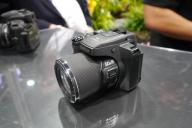
 P1000851.jpg800 x 533 - 98K
P1000851.jpg800 x 533 - 98K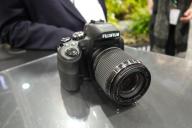
 P1000852.jpg800 x 533 - 105K
P1000852.jpg800 x 533 - 105K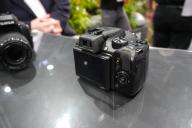
 P1000853.jpg800 x 533 - 104K
P1000853.jpg800 x 533 - 104K -
Some closer in photos of the GH-3 exploded view and a GH-3 magnesium alloy shell.
The lst photo is the opposite side of the circuit board. It was hard to get a view of it so the photo is not great.
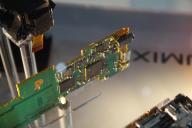
 P1000854.jpg800 x 533 - 105K
P1000854.jpg800 x 533 - 105K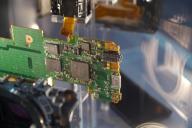
 P1000855.jpg800 x 533 - 117K
P1000855.jpg800 x 533 - 117K
 P1000856.jpg800 x 533 - 93K
P1000856.jpg800 x 533 - 93K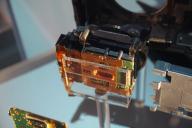
 P1000857.jpg800 x 533 - 102K
P1000857.jpg800 x 533 - 102K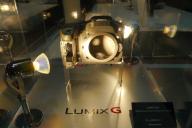
 P1000859.jpg800 x 533 - 111K
P1000859.jpg800 x 533 - 111K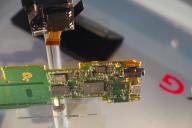
 P1000862.jpg800 x 533 - 105K
P1000862.jpg800 x 533 - 105K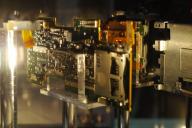
 P1000864.jpg800 x 533 - 129K
P1000864.jpg800 x 533 - 129K -
JVC's PX100. Amazing little camera.
Updated to 40 (yes 40) Mbps video encoding 1080/60p
Shoots 120 up to 600 fps too.

 P1000873.jpg800 x 533 - 81K
P1000873.jpg800 x 533 - 81K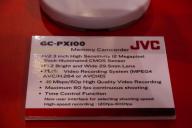
 P1000874.jpg800 x 533 - 109K
P1000874.jpg800 x 533 - 109K
 P1000875.jpg800 x 533 - 93K
P1000875.jpg800 x 533 - 93K -
The Sony TD30V replaces the TD20. Per the rep and my estimate, the TD30 returns to the 30mm stereobase separation. Price is lowered to US$999.95. Main changes are external SD card only now, no more internal memory for that. And the parallax adjustment has moved on to a menu item - its pretty straight forward user interface - provides both auto alignment and manual adjustment of parallax.
In 3D, the lens is as wide as 33mm full frame equivalent and in 2D its 29mm equivalent.
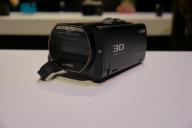
 P1000776.jpg800 x 533 - 58K
P1000776.jpg800 x 533 - 58K -
Sony also introduced a new "Balanced Optical Image Stabilization" system camcorder. This is a truly amazing amount of stabilization. Think of the lens being in its own floating box inside the camera. As the camera shakes, the lens is automatically moved opposite to the shake.
I have a video clip of this so you can watch the lens moving with the camera on their shake table. It was a brutal amount of shaking yet the camera provided smooth shots even in telephoto. However, due to my slow Internet access I will not be able to upload this for now. Hope in a couple of days or so I will have better access at a new location.
-
Fujifilm's new X20 is basically a compact version of the X Pro 1 and a 2x faster processor. It will sell for US $599. This camera features Fujifilm's own EXTRANS sensor technology. Rather than a Bayer pattern and the problems that causes with moire or fuzziness caused by the optical low pass filters, this sensor uses a random pattern sensor (the idea is to emulate film). This eliminates the need for an optical low pass filter, which means a sharper image and no moire.
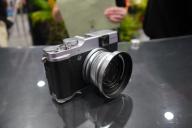
 P1000848.jpg800 x 533 - 94K
P1000848.jpg800 x 533 - 94K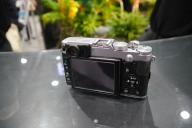
 P1000849.jpg800 x 533 - 103K
P1000849.jpg800 x 533 - 103K -
JVC introduced their own "action camera". Everyone is gunning for GoPro.
The JVC records at 15 Mbps data rate, has up to 170 degree field of view, and features a built in LCD viewfinder on the side of the camera as standard. I believe the retail price will be $299 and Videomaker Magazine selected it as a best in show product introduction.
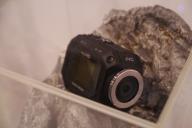
 P1000868.jpg800 x 533 - 83K
P1000868.jpg800 x 533 - 83K -
Also, Olympus, like last year, does not have a public show booth but is only having private meetings in the meeting rooms area.
-
Awesome coverage @edwardm
-
Thank you, @edwardm - good shit.
-
We spoke with LG Display (the pseudo-independent Korean display maker) here at CES and the company's reps tell us that all LCD makers are looking to move their business models on from cheap mass production to higher-margin, premium offerings. Having been burned by the costs of tooling up large factories for extremely price-sensitive screens, guys like LGD are now looking to innovate and secure their future viability by selling fewer, but more profitable displays.
Via: TheVerge
CES 2013 main idea in one paragraph.
Howdy, Stranger!
It looks like you're new here. If you want to get involved, click one of these buttons!
Categories
- Topics List23,979
- Blog5,725
- General and News1,352
- Hacks and Patches1,153
- ↳ Top Settings33
- ↳ Beginners255
- ↳ Archives402
- ↳ Hacks News and Development56
- Cameras2,362
- ↳ Panasonic991
- ↳ Canon118
- ↳ Sony156
- ↳ Nikon96
- ↳ Pentax and Samsung70
- ↳ Olympus and Fujifilm100
- ↳ Compacts and Camcorders300
- ↳ Smartphones for video97
- ↳ Pro Video Cameras191
- ↳ BlackMagic and other raw cameras116
- Skill1,961
- ↳ Business and distribution66
- ↳ Preparation, scripts and legal38
- ↳ Art149
- ↳ Import, Convert, Exporting291
- ↳ Editors191
- ↳ Effects and stunts115
- ↳ Color grading197
- ↳ Sound and Music280
- ↳ Lighting96
- ↳ Software and storage tips267
- Gear5,414
- ↳ Filters, Adapters, Matte boxes344
- ↳ Lenses1,579
- ↳ Follow focus and gears93
- ↳ Sound498
- ↳ Lighting gear314
- ↳ Camera movement230
- ↳ Gimbals and copters302
- ↳ Rigs and related stuff272
- ↳ Power solutions83
- ↳ Monitors and viewfinders339
- ↳ Tripods and fluid heads139
- ↳ Storage286
- ↳ Computers and studio gear560
- ↳ VR and 3D248
- Showcase1,859
- Marketplace2,834
- Offtopic1,319






